Introduction
Although they are quite different, Csound and Quartz Composer are great specialised programming languages that can compliment each other as part of a larger creative project. Csound has become a valuable tool for live musical performance and when used in conjunction with a graphical programming language such as Apple's Quartz Composer[1], it is possible to create rich interactive audio visual installations. In this article I will explain how to create a simple step sequencer with Csound and Quartz Composer. By describing this simple example, the aim of this tutorial is to outline the fundamental concepts of programming graphics with Quartz Composer and handling two way communication between Quartz Compositions and a Csound audio backend. The sequencer will receive its input from a GUI created with Quartz Composer and the sequencer's pattern state and audio will all be handled through Csound. The GUI will also show visual feedback of the sequencer's tempo and which notes are selected within the sequence. In this tutorial all communication between Csound and Quartz Composer will be handled using Open Sound Control (OSC). The advantages of using OSC control over MIDI or the software bus is that it offers the flexibility of either having an instance of Csound and Quartz Composer running on the same system or communicating between two separate systems over a LAN or the Internet with very few modifications. For processor intensive applications, this kind of flexibility can be hugely beneficial.
I. The Step Sequencer Interface
The step sequencer we are going to create will contain eight rectangular buttons that, when activated, will trigger an instrument in Csound. To begin the project we will lay out the buttons in Quartz Composer first and then start adding communication between our GUI and the necessary Csound instruments.
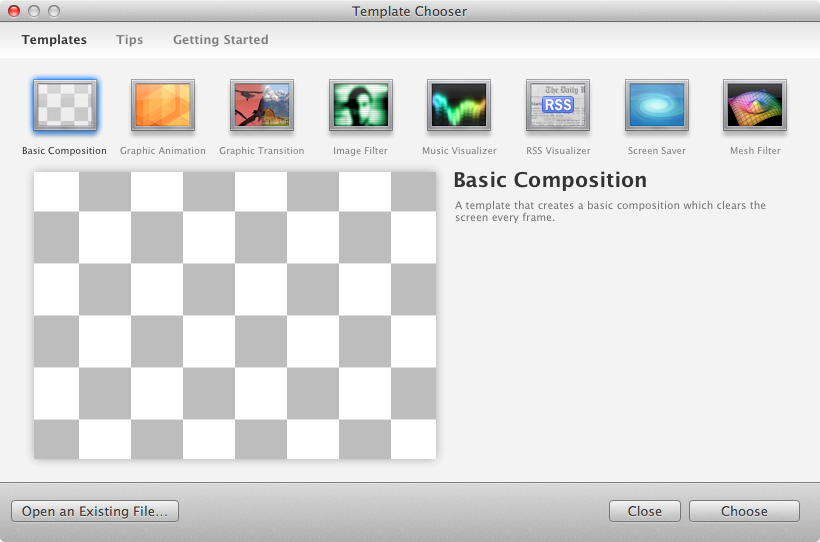
Figure 1. Quartz Composer's template chooser window
Creating an Interactive Button
Start by opening a new file in Quartz Composer that is of the type Basic Composition. This will give you a document that contains one Clear patch. This patch paints the target rendering layer with a constant colour and clears the depth buffer preventing unwanted visual artefacts from appearing in the composition. Quartz Composer comes with a library of patches that can be used to create a composition, these range from patches that perform basic mathematical operations to 3D rendering and visual effects patches[2]. The patch library can be opened through the Window menu bar item or using the ⌘ + ↵ (Apple key and Return key) combination. Specific patches within the library can be browsed through the scrollable menu or found by typing their title in the search field. When selected, patches can be placed into the composition by double clicking them with the mouse or by pressing the return key. The rectangular buttons of our step sequencer are going to be rendered to the screen using a Sprite patch. Select a Sprite patch from the library and add it to the composition.
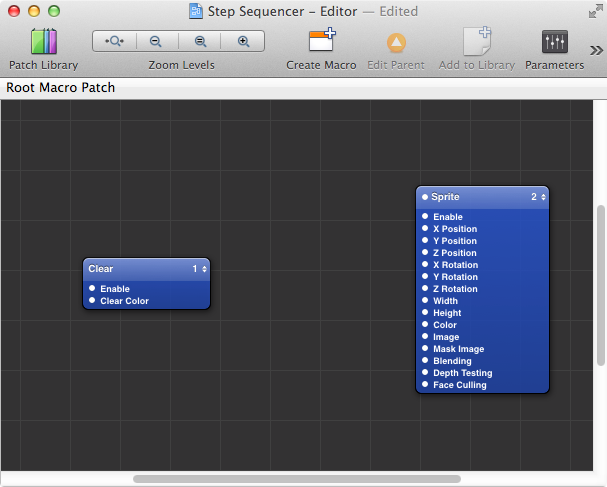
Figure 2. The patch editor
Patches can be connected to each other by clicking and dragging a connector cable from one patch's outlet to another patch's inlet. The outlets of a patch are represented by labelled white circles on the right and the inlets are the labelled white circles on the left side of a patch. The shape of our Sprite patch is determined by the patch's Image inlet. As we need a rectangular button we will use the Rounded Rectangle patch as its image input.

Figure 3. Connecting the Rounded Rectangle Image outlet to the Sprite Image inlet
Add a Rounded Rectangle patch from the library and connect the Image outlet of the Rounded Rectangle patch to the Image inlet of the Sprite patch. You can see the result of this connection in the Viewer window which shows a render of the Quartz Composition in realtime. To open the Viewer window press ⌘ + ⇑+ v (Command and Shift and 'v'), and press the Run button on the Viewer window if it is not currently rendering. You should now see the shape of the Rounded Rectangle rendered in the Viewer window.
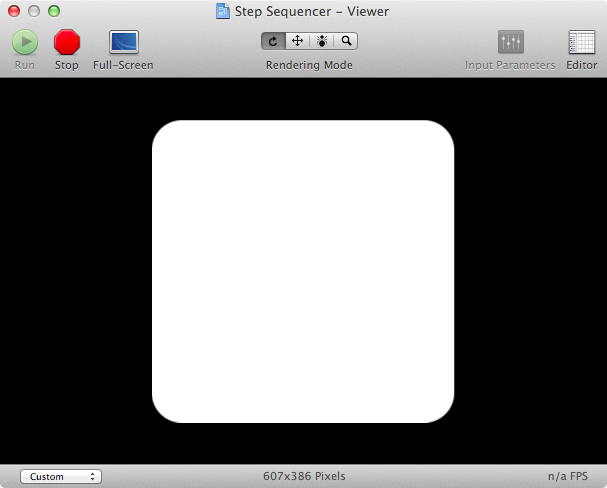
Figure 4. Viewer window
Select the Sprite object by clicking on it. When it is selected it will have a yellow border around its edge. Now open the Patch Inspector for the Sprite patch by pressing ⌘ + i (Command key and 'i').
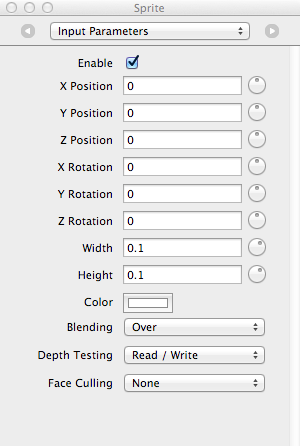
Figure 5. Patch Inspector
The Patch Inspector has three pages of properties that can be adjusted within a patch, the Input Parameters, Settings and Published Inputs & Outputs pages. These are selected by the drop down menu or arrow keys at the top of the Patch Inspector window. You can adjust the Height and Width of the Sprite patch by rotating the round knobs beside the Height and Width parameters or by typing the value directly into the text field.
Now make the Height and Width of the Sprite patch 0.1. You should be able to see the rectangle has become a lot smaller in the Viewer window. This white rounded rectangle is going to be used as a button for our simple step sequencer. However, in order for it to be useful, it has to be able to detect mouse events from the user. To do this, add an Interaction patch to the workspace and connect its interaction outlet to the interaction inlet of the Sprite patch. These outlets and inlets are not labelled but they are located at the very top of the Interaction and Sprite objects.
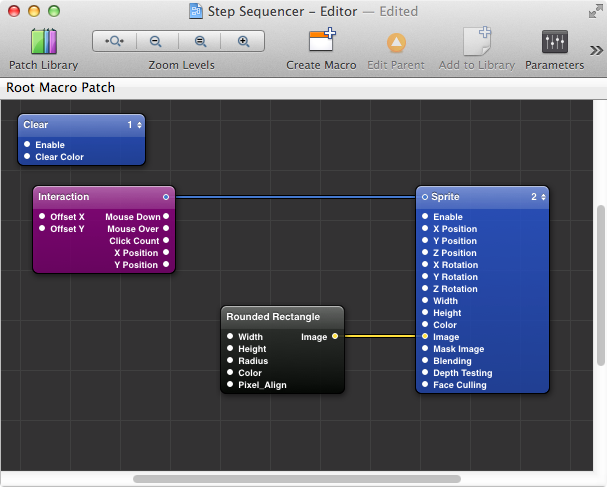
Figure 6. Connecting the Interaction patch interaction outlet to the Sprite patch interaction inlet
In order to get some visual feedback of when the buttons of our step sequencer are being interacted with we will change their size when they receive a mouse click. The Interaction patch will output a value of true from its Mouse Down outlet when a mouse click event is detected over the Sprite patch, otherwise the value is false. We can use this value to scale the size of our rectangular button.
Add a Mathematical Expression patch to the workspace. Open the workspace Patch Inspector and go to the Settings page. Edit the expression field so it reads:
mouseDown == true ? 0.15 : 0.1
So if the variable mouseDown is equal to true (a mouse click has been detected), output 0.15, if not (no mouse clicks have been detected), output 0.1. The inlets of the Mathematical Expression patch will have changed so there is an inlet labelled mouseDown and there should also be an outlet labelled Result. Connect from the Mouse Down outlet of the Interaction patch to the mouseDown inlet of the Mathematical Expression patch, then connect from the Mathematical Expression Result outlet to the Width and Height inlets of the Sprite patch.
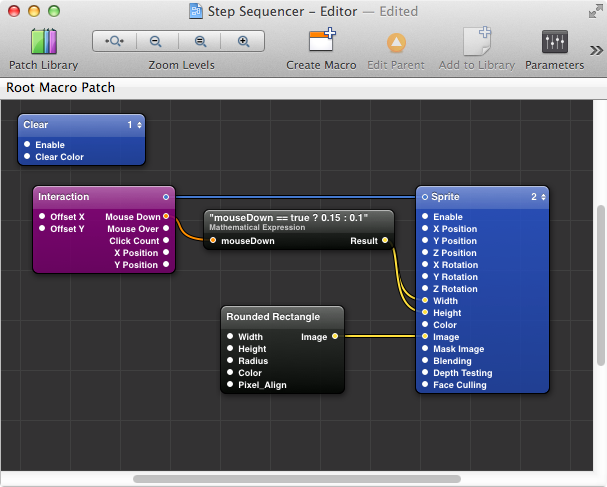
Figure 7. Adding a Mathematical Expression patch
Clicking on the rectangle in the Viewer window should now result in the rectangle increasing in size.
Duplicating the Button for an Eight Step Sequencer
As our step sequencer will consist of eight of these rectangle buttons, we need to duplicate every patch in our composition eight times. This can be achieved using an Iterator patch which is similar to a for loop construction used in most other programming languages. An Iterator patch is a type of macro patch, which means you can nest other patches inside of it. As we want eight copies of the rectangular button we need to place all the patches that make up the button into the Iterator and set it to iterate eight times.
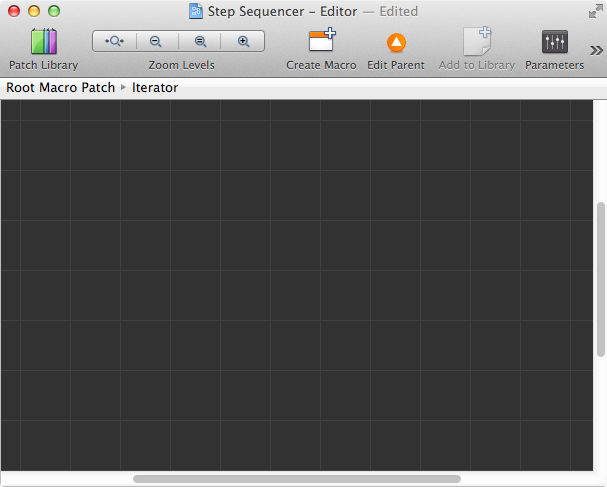
Figure 8. Inside of an Iterator patch
Add an Iterator patch to the workspace. You will notice its edges are squared indicating that it is a macro patch. In order to add other patches to the Iterator you can double click it in the area below its label (note that double-clicking the label allows you to edit its label). The address bar at the top left of the window will change indicating where you are in relation to the top patch level or Root Macro Patch. To move back to the top level you can either click the Edit Parent button in the menu bar, click Root Macro Patch in the address bar, or press ⌘ + u. Navigate back to the Root Macro Patch and select every object in the workspace except for the Iterator and Clear objects. This can be done by clicking and dragging across the relevant objects until they are highlighted in yellow. Press ⌘ + x to cut these objects, then double click the Iterator to navigate inside it and press ⌘ + v to paste the objects into it.
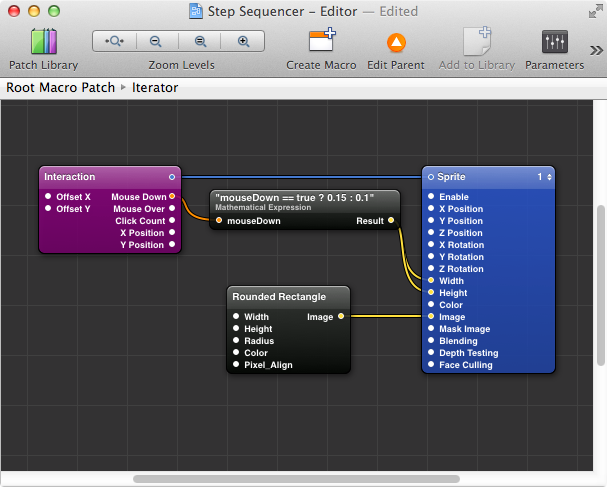
Figure 9. The sequencer button patches copied into an Iterator patch
While inside the Iterator patch, and making sure none of the objects are selected, press ⌘ + t to open the Parameters area to the right of the workspace. This shows the same settings that are in the Input Parameters Patch Inspector page of selected patches within the workspace. As we are currently viewing the contents of the Iterator patch the Parameters area will show the number of iterations the patch performs. Change the Iterations value to eight and make sure the Enable checkbox is ticked.

Figure 10. Changing the Iterations value using the Parameters area
The Iterator will have made eight copies of our button but we now need to translate them across the Viewer so they can be selected individually by the mouse.
Each iteration within an Iterator patch has an associated index which can be used to access a particular instance of our step sequencer buttons. The Iterator index values are accessed using the Iterator Variables patch placed inside an Iterator patch. We will use the Current Index number from the Iterator Variables patch as a scalar which will change the X position of the Sprite object.
Add an Iterator Variables patch and Mathematical Expression patch to the Iterator's workspace. Enter this expression in the Mathematical Expression patch's settings page (in the Patch Inspector):
index * scale - offset
This will create inlets for index, scale and offset on the Mathematical Expression patch.
Connect the Current Index outlet on the Iterator Variables patch to the index inlet of the Mathematical Expression patch. Next, connect the Result outlet from the Mathematical Expression patch to the X Position inlet of the Sprite patch. Now open the Patch Inspector for the Mathematical Expression patch to the Input Parameters page and set the value of scale to '0.13' and offset to '0.47'. In the Viewer window you should now see the step-sequencers buttons arranged into a horizontal row.
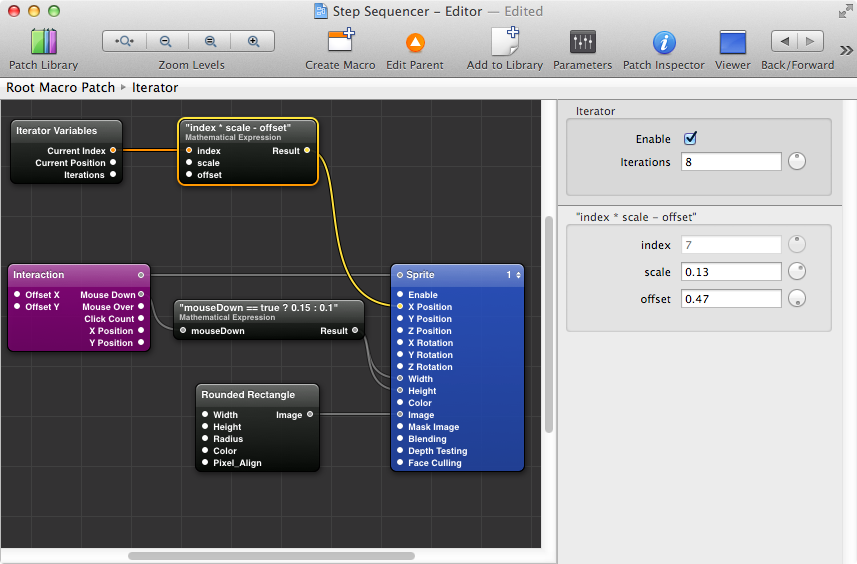
Figure 11. Adjusting the position of the sequencer buttons using a Mathematical Expression patch
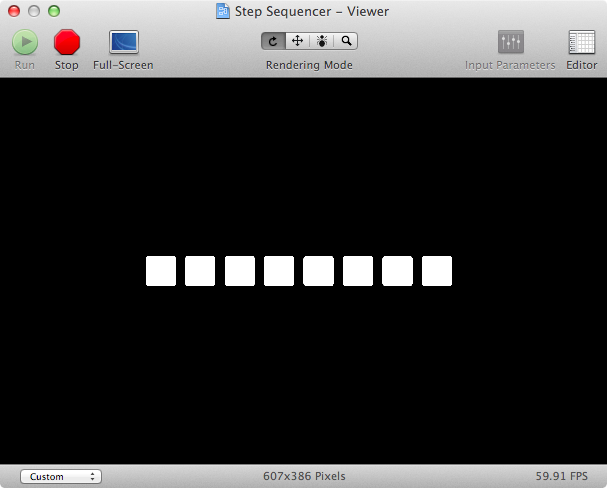
Figure 12. Viewer window showing the sequencer buttons arranged into a row
II. Adding a Visual Metronome Using Csound
At this point we can begin working with Csound. We will start by creating a visual metronome for the step sequencer which will give an indication of the speed and phase of our sequencer. Csound will create a phasor signal which will be sent via OSC to Quartz Composer. Quartz Composer will then increase the size of the sequencer button corresponding to the current phase of the sequence.
We will begin with a basic Csound file template:
<CsoundSynthesizer> <CsOptions> </CsOptions> <CsInstruments> sr = 44100 ksmps = 128 nchnls = 2 0dbfs = 1 instr Init, 1 endin </CsInstruments> <CsScore> i "Init" 0 100 </CsScore> </CsoundSynthesizer>
Here we have created an empty instrument entitled Init which will run for 100 seconds. In our Quartz composition the Iterator patch has made eight copies of the step sequencer button. It is important to note that the Iterator patch starts the index count from zero, like many other programming languages, so the first button will be Iterator index zero and the last will be Iterator index seven. If we make a metronome that counts from zero to seven in Csound, we can send these values to Quartz Composer via OSC. We can then check if the number being sent from Csound is the same as the button's index that we want to increase in size. If it is, we will increase the size of the button, if not, the button's size will be unaltered.
To create a metronome in Csound, we first add a table to the Init instrument which will contain values from zero to seven.
<CsoundSynthesizer>
<CsOptions>
</CsOptions>
<CsInstruments>
sr = 44100
ksmps = 128
nchnls = 2
0dbfs = 1
instr Init, 1
gi_MetroTable ftgen 0, 0, 8, -2, 0, 1, 2, 3, 4, 5, 6, 7
endin
</CsInstruments>
<CsScore>
i "Init" 0 100
</CsScore>
</CsoundSynthesizer>
Next we add the Clock instrument, this will contain the phasor opcode which will generate a global control signal that will be used to move through the values of the table we have created. The phasor is set to repeat once every second.
<CsoundSynthesizer>
<CsOptions>
</CsOptions>
<CsInstruments>
sr = 44100
ksmps = 128
nchnls = 2
0dbfs = 1
instr Init, 1
gi_MetroTable ftgen 0, 0, 8, -2, 0, 1, 2, 3, 4, 5, 6, 7
endin
instr Clock, 10
gk_Phasor phasor 1
endin
</CsInstruments>
<CsScore>
i "Init" 0 100
</CsScore>
</CsoundSynthesizer>
Now add an instrument that will read the current value from the gi_MetroTable table using the phasor control signal.
<CsoundSynthesizer>
<CsOptions>
</CsOptions>
<CsInstruments>
sr = 44100
ksmps = 128
nchnls = 2
0dbfs = 1
instr Init, 1
gi_MetroTable ftgen 0, 0, 8, -2, 0, 1, 2, 3, 4, 5, 6, 7
endin
instr Clock, 10
gk_Phasor phasor 1
endin
instr TableReader, 20
gk_Metronome table gk_Phasor, gi_MetroTable, 1
endin
</CsInstruments>
<CsScore>
i "Init" 0 100
</CsScore>
</CsoundSynthesizer>
We can test to see if the metronome is working correctly by turning on the Clock and TableReader instruments from the Init instrument and printing the gk_Metronome value. The turnon opcode in Csound only takes instrument numbers as an argument so for the sake clarity I have made definitions at the beginning of the Csound file that will show which instruments are being activated.
<CsoundSynthesizer>
<CsOptions>
</CsOptions>
<CsInstruments>
sr = 44100
ksmps = 128
nchnls = 2
0dbfs = 1
#define Clock #10#
#define TableReader #20#
instr Init, 1
turnon $Clock
turnon $TableReader
gi_MetroTable ftgen 0, 0, 8, -2, 0, 1, 2, 3, 4, 5, 6, 7
endin
instr Clock, 10
gk_Phasor phasor 1
endin
instr TableReader, 20
gk_Metronome table gk_Phasor, gi_MetroTable, 1
printk2 gk_Metronome
endin
</CsInstruments>
<CsScore>
i "Init" 0 100
</CsScore>
</CsoundSynthesizer>
Once the metronome is working we can send the output values to Quartz Composer using the OSCsend opcode. The OSCsend opcode is created in a new instrument entitled OSCSendMetronome.
<CsoundSynthesizer>
<CsOptions>
</CsOptions>
<CsInstruments>
sr = 44100
ksmps = 128
nchnls = 2
0dbfs = 1
#define Clock #10#
#define TableReader #20#
#define OSCSendMetronome #30#
instr Init, 1
turnon $Clock
turnon $TableReader
turnon $OSCSendMetronome
gi_MetroTable ftgen 0, 0, 8, -2, 0, 1, 2, 3, 4, 5, 6, 7
endin
instr Clock, 10
gk_Phasor phasor 1
endin
instr TableReader, 20
gk_Metronome table gk_Phasor, gi_MetroTable, 1
printk2 gk_Metronome
endin
instr OSCSendMetronome, 30
OSCsend gk_Metronome, "127.0.0.1", 20002, "/phasor", "f", gk_Metronome
endin
</CsInstruments>
<CsScore>
i "Init" 0 100
</CsScore>
</CsoundSynthesizer>
This will transmit the metronome values to port 20002 of the TCP/IP loopback device at address 127.0.0.1/phasor. The instrument is turned on from the Init instrument and uses the instrument name definition at the beginning of the file.
Back in Quartz Composer there needs to be an OSC Receiver patch that will listen for the values being transmitted by Csound. In Quartz Composer navigate to the Root MacroPatch, the top most level of your composition, which contains the Clear and Iterator patches.
Add an OSC Receiver patch and open the Settings page in the Patch Inspector. Change the Port Number value to 20002, then remove the /test key from the OSC Arguments section. Next, add a key of type Float to the OSC Arguments and name it /phasor, the path we specified in our OSCsend arguments in Csound.
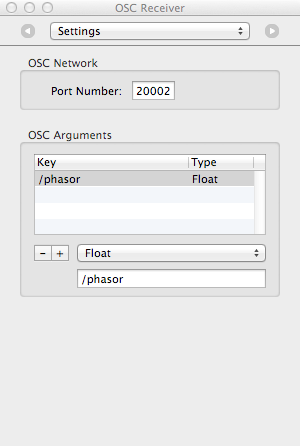
Figure 13. OSC Receiver patch Settings page
We now need to create an inlet on our Iterator patch for the OSC Receiver /phasor outlet. Navigate to inside the Iterator patch, create a Mathematical Expression patch and enter the following equation:
index == metronome ? .02 : 0
When the value of the index inlet is equal to the metronome value which we will be sent from Csound, this patch will output the value of .02, otherwise it will just output 0. Connect the Iterator Variable's Current Index outlet to the index inlet of the Mathematical Expression patch we just created. Note that you can take as many connections from a patches outlet as you want, you can however only have one connection into an inlet. You should have two connection lines coming out from the Iterator Variable's Current Index outlet now.
Right click (or ctrl + click), on the new Mathematical Expression object and select Publish Inputs > metronome. This will create an inlet for the Iterator patch that we can use to input OSC messages. You will be given the option to rename the published input, however this step is not necessary. Navigate up one level back to the Root Macro Patch—you should see a new inlet in the Iterator—and connect from the OSC Receiver /phasor outlet to the metronome inlet.
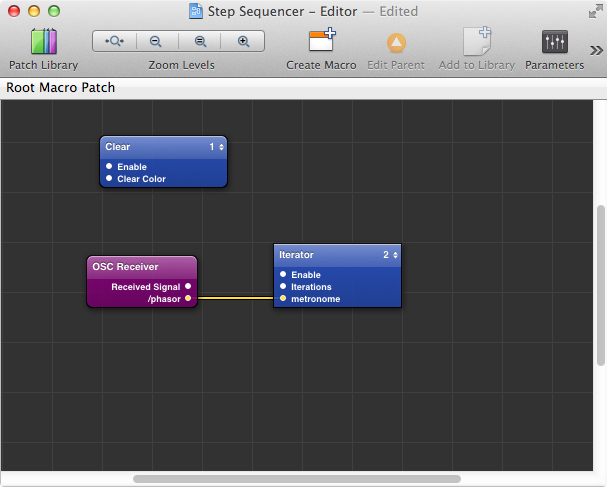
Figure 14. OSC Receiver patch connected to the Iterator patch
Now that the Iterator is receiving OSC messages we can alter the size of our sequencer buttons depending on which message is received. Inside the Iterator patch create a Math patch, connect the Result outlets from the Mathematical Expression patches with the equations:
index == metronome ? .02 : 0
and
mouseDown == true ? 0.15 : 0.1
to the inlets of the Math patch, then connect the single outlet from the Math patch to the Width and Height inlets of the Sprite patch. (Note that this will remove the previous connections that were made to these inlets as inlets may only have one input.)
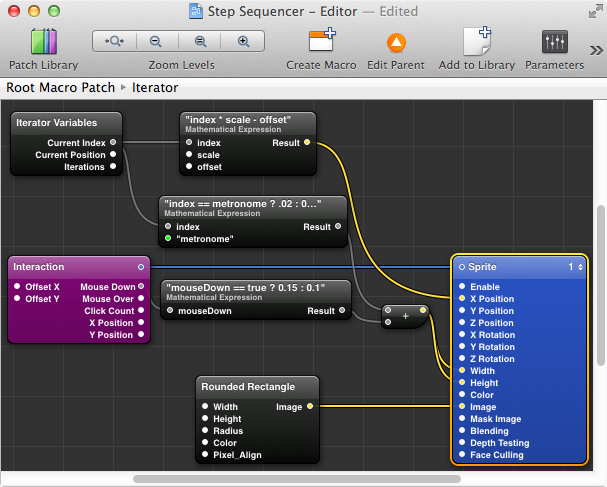
Figure 15. Connecting a Math patch to the Sprite Width and Height inlets
By running the Csound instrument now you should see the sequencer buttons changing size while moving from left to right in the Quartz Composer Viewer.
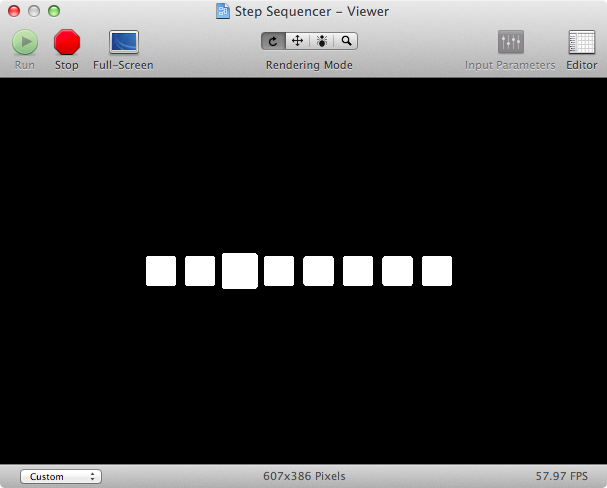
Figure 16. Viewer window showing the visual metronome
Sending the Step Sequencer Button State to Csound using OSC
Now that our visual metronome is complete, we can start sending messages back to Csound from Quartz Composer. Next we will make it so that when a button has been clicked in the step sequence, it will trigger an audio signal in Csound.
Csound needs to know which of the eight buttons the user clicked on, so we will need to receive output from the Iterator Variables Current Index outlet in combination with the Interaction patch's Mouse Down outlet. We can send both of these variables within a single OSC message to Csound using a Structure.
The best way of creating a Structure in Quartz Composer is to use a Javascript patch where we can programmatically combine different variables from Structure's inlets. Add a Javascript patch inside of the Iterator patch and open its Patch Inspector.
Replace the default Javascript code with the following code:
function (__structure output) main (__number index, __boolean mouseDown)
{
var result = new Object();
var outArray = new Array();
outArray[0] = index;
outArray[1] = mouseDown == true ? 1 : 0;
result.output = outArray;
return result;
}
The first line of this code is the function declaration. The brackets on the left contain the output variable (here it is a structure), and the input variables are in the brackets on the right (here they are a number and a boolean value). The variable result is the object that returns the output structure. The variable outArray is an array that will store the data within the structure. It will store the index number (the current Iteration), and a number representing the mouse state. The mouse state number will be 1 if the mouseDown value is true and 0 if it is false.
To output the Structure as OSC messages to Csound we need to use an OSC Sender patch. Add an OSC Sender patch to the Iterator patch and go to the Settings page within its Patch Inspector. Change its IP Address field to 127.0.0.1 and the Port Number field to 10001. Next add an OSC Argument with a key of /buttons and type of Floats.
Now that the Javascript and OSC Sender patches are correctly configured we can connect them to the rest of the composition. Connect from the Mouse Down inlet in the Interaction patch to mouseDown in the Javascript patch, then connect Current Index from Iterator Variables patch to the index inlet in the Javascript patch. Finally connect from the output outlet in the Javascript patch to the /buttons inlet in the OSC Sender patch.
Next we need to make sure that the OSC Sender patch is enabled and sending a single OSC message per mouse click. To accomplish this, create a Pulse patch and in its InputParameters page set the Detection Mode to Both. Connect Mouse Down from the Interaction patch to the Input Signal inlet in the Pulse patch, then connect the Pulse outlet from the Pulse patch to the Enable inlet in the OSC Sender patch.

Figure 17. Pulse and Javascript patches connected to the OSC sender patch
Back in Csound we now need to create an instrument which will store the sequencers current button states. To do this we will create an instrument with a table to store the button states and an OSC receiver instrument which will relay the button state information to the instrument.
First we will create the OSC receiver instrument, to do so add the following code to Csound:
<CsoundSynthesizer>
<CsOptions>
</CsOptions>
<CsInstruments>
sr = 44100
ksmps = 128
nchnls = 2
0dbfs = 1
#define Clock #10#
#define TableReader #20#
#define OSCSendMetronome #30#
#define OSCReceive #40#
gi_OSCHandle OSCinit 10001
instr Init, 1
turnon $Clock
turnon $TableReader
turnon $OSCSendMetronome
turnon $OSCReceive
gk_ButtonNumber init 0
gk_ButtonState init 0
gi_MetroTable ftgen 0, 0, 8, -2, 0, 1, 2, 3, 4, 5, 6, 7
gi_TriggerTable ftgen 0, 0, 8, -2, 0, 0, 0, 0, 0, 0, 0, 0
endin
instr Clock, 10
gk_Phasor phasor 1
endin
instr TableReader, 20
gk_Metronome table gk_Phasor, gi_MetroTable, 1
endin
instr OSCSendMetronome, 30
OSCsend gk_Metronome, "127.0.0.1", 20002, "/phasor", "f", gk_Metronome
endin
instr OSCReceive, 40
nxtmsg:
k_OSCReceived OSClisten gi_OSCHandle, "/buttons", "ii", gk_ButtonNumber, gk_ButtonState
if (k_OSCReceived == 0) goto ex
kgoto nxtmsg
endif
ex:
endin
</CsInstruments>
<CsScore>
i "Init" 0 100
</CsScore>
</CsoundSynthesizer>
Here we initialise our OSC listener to listen on port 10001 using the OSCinit opcode at the beginning of the file. In the Init instrument we then create the global variables to store the button number and state. The table for storing this information is created and called gk_TriggerTable. The OSCReceive instrument uses the OSClisten opcode to receive OSC messages from Quartz Composer, in this case it is receiving two integer variables which are accessed using the gk_ButtonNumber and gk_ButtonState variables.
To test if we are receiving OSC from Quartz Composer, add two print statements to the Init instrument for the gk_ButtonNumber and gk_ButtonState variables and click on the sequencer buttons within the Quartz Composer Viewer window. Also, by removing the metronome print statement within the TableReader instrument, this will make the Csound terminal output easier to read.
instr Init, 1
turnon $Clock
turnon $TableReader
turnon $OSCSendMetronome
turnon $OSCReceive
gk_ButtonNumber init 0
gk_ButtonState init 0
printk2 gk_ButtonNumber
printk2 gk_ButtonState
gi_MetroTable ftgen 0, 0, 8, -2, 0, 1, 2, 3, 4, 5, 6, 7
gi_TriggerTable ftgen 0, 0, 8, -2, 0, 0, 0, 0, 0, 0, 0, 0
endin
If everything is working correctly you should see the numbers corresponding to the buttons being clicked printed in the Csound output terminal.
The values in the button state table will need to alternate between zero and one whenever Csound receives a message from the corresponding Quartz Composer sequencer button.
We will now create an instrument which changes the value of the table depending on its current state and the input from the OSCReceive instrument.
<CsoundSynthesizer>
<CsOptions>
</CsOptions>
<CsInstruments>
sr = 44100
ksmps = 128
nchnls = 2
0dbfs = 1
#define Clock #10#
#define TableReader #20#
#define OSCSendMetronome #30#
#define OSCReceive #40#
gi_OSCHandle OSCinit 10001
instr Init, 1
turnon $Clock
turnon $TableReader
turnon $OSCSendMetronome
turnon $OSCReceive
gk_ButtonNumber init 0
gk_ButtonState init 0
gi_MetroTable ftgen 0, 0, 8, -2, 0, 1, 2, 3, 4, 5, 6, 7
gi_TriggerTable ftgen 0, 0, 8, -2, 0, 0, 0, 0, 0, 0, 0, 0
endin
instr Clock, 10
gk_Phasor phasor 1
endin
instr TableReader, 20
gk_Metronome table gk_Phasor, gi_MetroTable, 1
printk2 gk_Metronome
endin
instr OSCSendMetronome, 30
OSCsend gk_Metronome, "127.0.0.1", 20002, "/phasor", "f", gk_Metronome
endin
instr OSCReceive, 40
nxtmsg:
k_OSCReceived OSClisten gi_OSCHandle, "/buttons", "ii", gk_ButtonNumber, gk_ButtonState
if (k_OSCReceived == 0) goto ex
if (gk_ButtonState == 1) then
event "i", "TableWriter", 0, -1
endif
kgoto nxtmsg
endif
ex:
endin
instr TableWriter, 50
k_CurrentValue table gk_ButtonNumber, gi_TriggerTable
if (k_CurrentValue == 0) then
tablew 1, gk_ButtonNumber, gi_TriggerTable
else
tablew 0, gk_ButtonNumber, gi_TriggerTable
endif
turnoff
endin
</CsInstruments>
<CsScore>
i "Init" 0 100
</CsScore>
</CsoundSynthesizer>
Here we have set up a trigger inside the OSCReceive instrument that will activate our new TableWriter instrument when gk_ButtonState value is 1 using the event opcode.
When the TableWriter instrument is triggered, it reads the value of the table gi_TriggerTable at the index it receives from Quartz Composer. If this value is 0 it writes a 1 to this index, if the value is 1 it writes a 0. This instrument then turns itself off as we need only one control pass to perform the necessary operations.
Adding Visual Feedback for the Step Sequencer Button State
At this point the buttons in Quartz Composer are triggering our TableWriter instrument to change the values of the gi_TriggerTable but as yet we have no visual feedback of the tables current value. We can fix this by sending an OSC message back to Quartz Composer when values have been written into the table. We can then increase the size of the button to indicate its current corresponding table value.
<CsoundSynthesizer>
<CsOptions>
</CsOptions>
<CsInstruments>
sr = 44100
ksmps = 128
nchnls = 2
0dbfs = 1
#define Clock #10#
#define TableReader #20#
#define OSCSendMetronome #30#
#define OSCReceive #40#
gi_OSCHandle OSCinit 10001
instr Init, 1
turnon $Clock
turnon $TableReader
turnon $OSCSendMetronome
turnon $OSCReceive
gk_ButtonNumber init 0
gk_ButtonState init 0
gi_MetroTable ftgen 0, 0, 8, -2, 0, 1, 2, 3, 4, 5, 6, 7
gi_TriggerTable ftgen 0, 0, 8, -2, 0, 0, 0, 0, 0, 0, 0, 0
endin
instr Clock, 10
gk_Phasor phasor 1
endin
instr TableReader, 20
gk_Metronome table gk_Phasor, gi_MetroTable, 1
printk2 gk_Metronome
endin
instr OSCSendMetronome, 30
OSCsend gk_Metronome, "127.0.0.1", 20002, "/phasor", "f", gk_Metronome
endin
instr OSCReceive, 40
nxtmsg:
k_OSCReceived OSClisten gi_OSCHandle, "/buttons", "ii", gk_ButtonNumber, gk_ButtonState
if (k_OSCReceived == 0) goto ex
if (gk_ButtonState == 1) then
event "i", "TableWriter", 0, -1
endif
kgoto nxtmsg
endif
ex:
endin
instr TableWriter, 50
k_CurrentValue table gk_ButtonNumber, gi_TriggerTable
if (k_CurrentValue == 0) then
tablew 1, gk_ButtonNumber, gi_TriggerTable
else
tablew 0, gk_ButtonNumber, gi_TriggerTable
endif
event "i", "OSCSendTableState", 0, -1
turnoff
endin
instr OSCSendTableState, 60
k0 table 0, gi_TriggerTable
k1 table 1, gi_TriggerTable
k2 table 2, gi_TriggerTable
k3 table 3, gi_TriggerTable
k4 table 4, gi_TriggerTable
k5 table 5, gi_TriggerTable
k6 table 6, gi_TriggerTable
k7 table 7, gi_TriggerTable
OSCsend 1, "127.0.0.1", 20002, "/tablestate", "ffffffff", k0, k1, k2, k3, k4, k5, k6, k7
turnoff
endin
</CsInstruments>
<CsScore>
i "Init" 0 100
</CsScore>
</CsoundSynthesizer>
In the code example above, just before the TableWriter instrument turns itself off, it triggers the OSCSendTableState instrument. This instrument reads all eight values from the gi_TriggerTable table and sends them to the address 127.0.0.1/tablestate. Now we need to make sure Quartz Composer can receive OSC messages at this address.
In Quartz Composer at the Root Macro Patch level open the Settings inspector of OSC Receiver, add a new key entitled /tablestate and select the Floats type from the drop down menu.
Navigate to inside the Iterator patch and create a Structure Index Member patch. This patch will output a single selected value from the OSC structure sent from the Csound OSCSendTableState instrument. To retrieve the correct value from the OSC structure connect from the Current Index outlet of the Iterator Variables patch to the Index inlet of the Structure Index Member patch. Next publish the Structure inlet of the Structure Index Member object and change its label to tablestate.
Create a new Mathematical Expression patch that contains the function:
member * scalar
Change the value of scalar in the Input Parameters inspector to 0.03. Open the Settings inspector for the Math patch inside the Iterator and change the number of operations to two. Now connect from the Member outlet in the Structure Index Member patch to the member inlet in the new Mathematical Expression patch and connect from its' Result outlet to the new inlet of the Math patch.
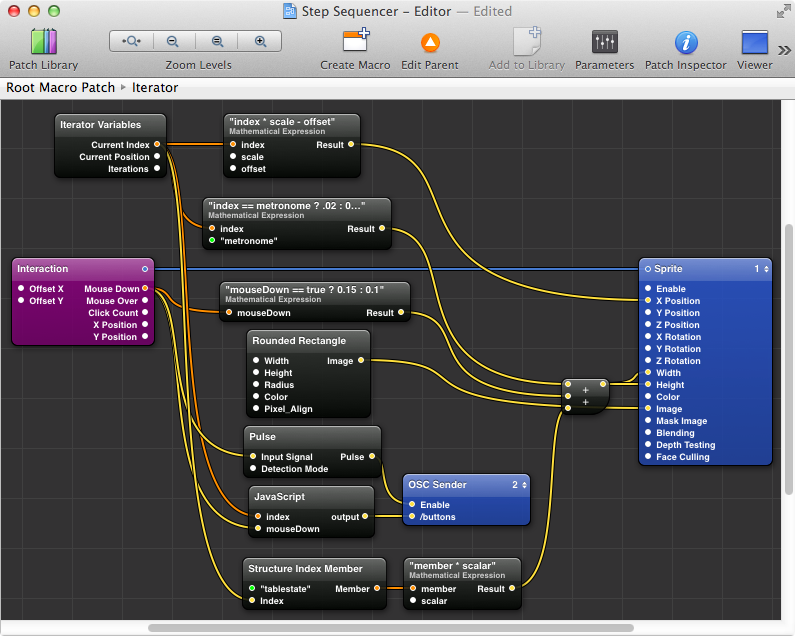
Figure 18. Structure Index Member and Mathematical Expression patches connected to the Math patch
Finally, go back to the Root Macro Patch level and connect from the OSC Receiver's /tablestate outlet to the tablestate inlet of the Iterator.
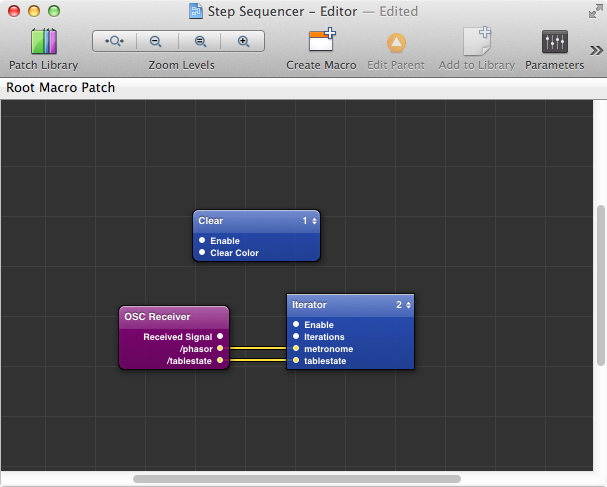
Figure 19. OSC Receiver sending tablestate values to Iterator patch
The sequencer buttons within Quartz Composer should now change their size depending on the table value in Csound.
III. Adding an Audio Synthesizer in Csound
At this point we can create our audio synthesiser within Csound. First we need to add some logic to the TableReader instrument so that it triggers a simple audio synthesiser instrument when it reads a 1 value from the gi_TriggerTable.
<CsoundSynthesizer>
<CsOptions>
</CsOptions>
<CsInstruments>
sr = 44100
ksmps = 128
nchnls = 2
0dbfs = 1
#define Clock #10#
#define TableReader #20#
#define OSCSendMetronome #30#
#define OSCReceive #40#
gi_OSCHandle OSCinit 10001
instr Init, 1
turnon $Clock
turnon $TableReader
turnon $OSCSendMetronome
turnon $OSCReceive
gk_ButtonNumber init 0
gk_ButtonState init 0
gi_MetroTable ftgen 0, 0, 8, -2, 0, 1, 2, 3, 4, 5, 6, 7
gi_TriggerTable ftgen 0, 0, 8, -2, 0, 0, 0, 0, 0, 0, 0, 0
endin
instr Clock, 10
gk_Phasor phasor 1
endin
instr TableReader, 20
gk_Metronome table gk_Phasor, gi_MetroTable, 1
k_Trigger table gk_Phasor, gi_TriggerTable, 1
k_Gate init 0
k_StopTime init 0
k_Timer times
if (k_Trigger == 1 && k_Gate == 0) then
event "i", "Beep", 0, 1/8
k_StopTime = k_Timer + (1/8)
k_Gate = 1
endif
if (k_Timer > k_StopTime) then
k_Gate = 0
endif
endin
instr OSCSendMetronome, 30
OSCsend gk_Metronome, "127.0.0.1", 20002, "/phasor", "f", gk_Metronome
endin
instr OSCReceive, 40
nxtmsg:
k_OSCReceived OSClisten gi_OSCHandle, "/buttons", "ii", gk_ButtonNumber, gk_ButtonState
if (k_OSCReceived == 0) goto ex
if (gk_ButtonState == 1) then
event "i", "TableWriter", 0, -1
endif
kgoto nxtmsg
endif
ex:
endin
instr TableWriter, 50
k_CurrentValue table gk_ButtonNumber, gi_TriggerTable
if (k_CurrentValue == 0) then
tablew 1, gk_ButtonNumber, gi_TriggerTable
else
tablew 0, gk_ButtonNumber, gi_TriggerTable
endif
event "i", "OSCSendTableState", 0, -1
turnoff
endin
instr OSCSendTableState, 60
k0 table 0, gi_TriggerTable
k1 table 1, gi_TriggerTable
k2 table 2, gi_TriggerTable
k3 table 3, gi_TriggerTable
k4 table 4, gi_TriggerTable
k5 table 5, gi_TriggerTable
k6 table 6, gi_TriggerTable
k7 table 7, gi_TriggerTable
OSCsend 1, "127.0.0.1", 20002, "/tablestate", "ffffffff", k0, k1, k2, k3, k4, k5, k6, k7
turnoff
endin
instr Beep
a_Out vco2 .2, 220
outs a_Out, a_Out
endin
</CsInstruments>
<CsScore>
i "Init" 0 100
</CsScore>
</CsoundSynthesizer>
A timer has been added to the TableReader instrument which will trigger the Beep instrument every 1/8th of a second. When the TableReader is activated the k_Gate and k_StopTime variables are initialised to zero it begins reading the values from the gi_TriggerTable. If the value read is a 1 and the k_Gate variable is 0 the Beep instrument is triggered for 1/8th of a second, the k_StopTime variable is set at the present instrument time plus 1/8th of a second and the k_Gate variable is set to 1. When the k_Timer variable is greater than the value of k_StopTime this means 1/8th of a second has passed and the k_Gate variable is set back to 0. The Beep instrument being triggered by the TableReader instrument is a very simple synthesiser using one vco2 oscillator set at an amplitude of 0.2 and a pitch of 220Hz.
If the Csound file is compiled and run with Quartz Composer running you can now click on the buttons within the composition and this will trigger the Beep instrument.
Colouring and Smoothing the Animations of the Step Sequencer Interface
Our step sequencer is now functionally complete but the presentation of the graphics can be improved greatly by modifying some parts of the composition. Instead of our buttons suddenly growing and shrinking we can make the size of the buttons grow with a smooth animation. We can also change the colours of the buttons, which makes them more aesthetically pleasing and adds more visual feedback regarding the gi_TriggerTable's current state.
Inside the Iterator patch add a Smooth object and connect from the outlet of the Math patch to the Value inlet of the Smooth patch. Also connect from the Smoothed Value outlet to the Width and Height inlets of the Sprite patch. Next set the Increasing Duration and Decreasing Duration values in the Smooth patches Input Parameters inspector to 0.1. This should smooth the increase and decrease in size of our step sequencers buttons.
To change the colour of the buttons create an RGB Color patch and connect its outlet to the Color inlet of the Sprite patch. In the Input Parameters inspector set the Red value to 1, leave the Green as it is, set the Blue to 0.25 and the Alpha to 1.
Make a new Mathematical Expression patch and enter the following formula:
smoothed * scalar
Set the scalar value to 5 in the Input Parameters inspector, then connect the Smoothed outlet from the Smooth object to smoothed inlet of the Mathematical Expression patch and the Result outlet to the Green inlet of the RGB Color patch.
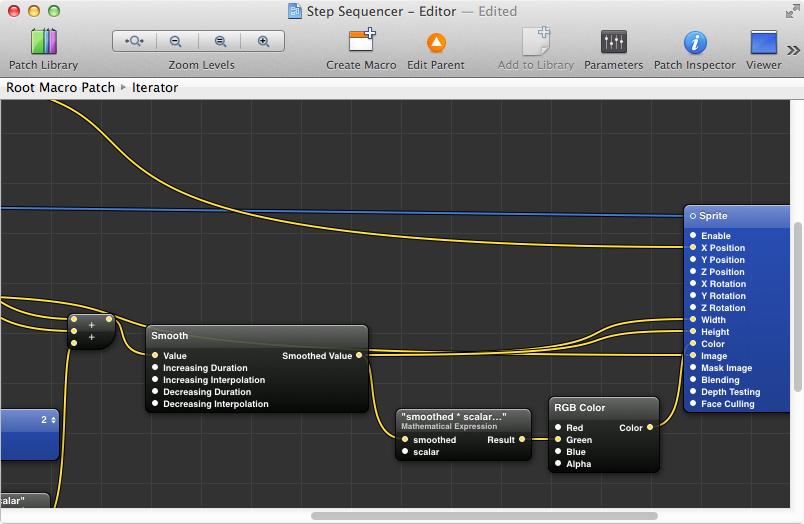
Figure 20. Smooth patch connected to Sprite width and height inlets and Mathematical Expression patch
If you compile and run the Csound file now you should see the colours of the buttons changing as they increase in size.
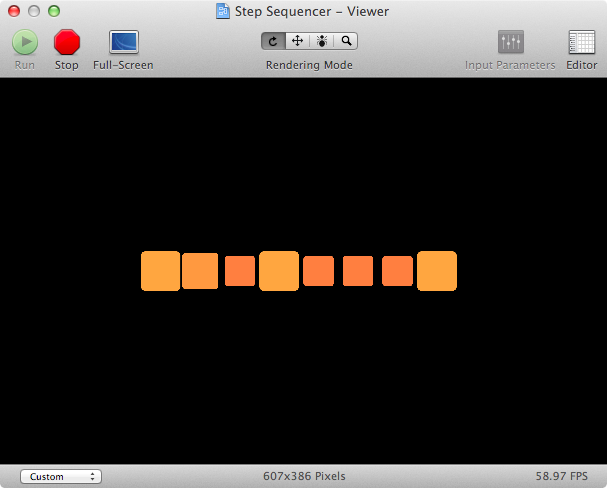
Fig 21. Completed step sequencer interface
Conclusion
Quartz Composer is a powerful language which allows the creation of complex interactive graphical elements. Although this is a simple example, this project shows how to make GUI for a Csound instrument using many of Quartz Composers features. This sequencer can be further expanded into a more fully featured interactive system by using just the patches outlined in this tutorial. For example another Iterator patch can be added to alter the pitch of the Csound instrument. By creating a further eight copies of the current eight buttons and arranging them into rows with a small amount of further patching each row can send a different pitch value.
References
[1]Quartz Composer visual programming environment included with Xcode. [Online]. Available: https://developer.apple.com/technologies/mac/graphics-and-animation.html. [Accessed October 9, 2012].
[2]QuartzComposer.com. (2009 - 2012). [Online]. Available: http://quartzcomposer.com/patches. [Accessed October 10, 2012].